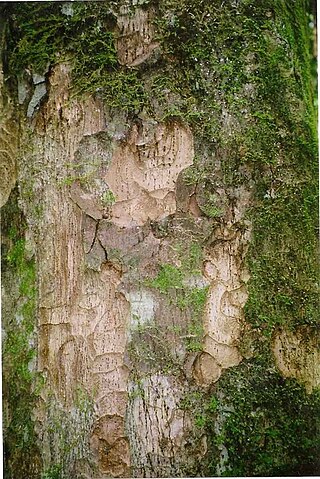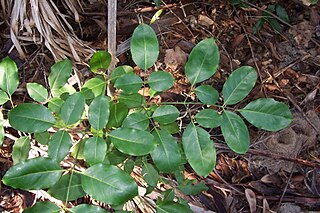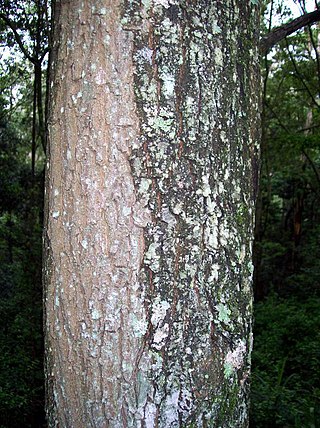
Planchonella costata is a small coastal tree native to the northern North Island and to Norfolk Island (Australia). In New Zealand, its common name is tawapou ; on Norfolk Island it is called bastard ironwood. The name costata is from the Latin costatus (ribbed), a reference to the prominently raised primary nerves of the leaves.

Planchonella australis, also known by the synonym Pouteria australis, is a medium to tall rainforest tree of the family Sapotaceae native to Queensland and New South Wales, Australia. It is known by the common name black apple, wild plum, yellow buttonwood, black plum and yellow bulletwood.

Pleioluma is a genus of flowering plants in the family Sapotaceae. It includes 40 species of evergreen hermaphroditic or gynodioecious trees, reaching up to 25 meters tall.

Litsea reticulata is a common Australian tree, growing from near Milton, New South Wales to the Bunya Mountains, Queensland. Common names include bollygum, bolly wood and brown beech. The habitat of the bollygum is rainforest of most types, except the dryer forms.

Cryptocarya glaucescens, commonly known as jackwood, is a rainforest tree of the laurel family growing in eastern Australia.

Beilschmiedia obtusifolia is a rainforest tree in the laurel family Lauraceae, found in rainforests of eastern Australia and also in New Guinea. In Australia it ranges from Port Macquarie in New South Wales northwards to Cape York Peninsula in Queensland, within tropical and sub tropical rainforests, usually on the more fertile basaltic sites, but sometimes close to the sea. Its common names include blush walnut, hard bolly gum, and nut wood.

Polyscias elegans, known as the celery wood, is a rainforest tree of eastern Australia. It occurs in a variety of different rainforest types, from fertile basaltic soils, to sand dunes and less fertile sedimentary soils. The range of natural distribution is from Jervis Bay in southern New South Wales to Thursday Island, north of the Australian continent. Other common names include black pencil cedar and silver basswood. Polyscias elegans is useful to bush regenerators as a nursery tree, which provides shade for longer-lived young trees underneath. Polyscias elegans is also known as Celery wood, Mowbulan whitewood, Silver basswood and White sycamore.

Backhousia leptopetala is a common Australian tree, growing from Stanwell Park in the northern Illawarra district to near Buderim in south eastern Queensland.

Psychotria loniceroides, the hairy psychotria, is a plant native to the forest areas of eastern Australia.

Polyscias sambucifolia, commonly known as elderberry panax or small basswood, is a species of plant native to eastern Australia.

Endiandra discolor is an Australian tree, growing from near Gosford, New South Wales to Tully, Queensland in the tropics. Common names include rose walnut and domatia tree.

Cryptocarya bidwillii, the yellow laurel, is a small to medium-sized tree in the laurel family. Occurring in Australian rainforests from Nymboida in the state of New South Wales to Townsville in tropical Queensland. Often found in the dryer ridges in dry rainforest or in viney scrubs.

Bridelia exaltata, known as the brush ironbark or scrub ironbark, is a tree of eastern Australia. It occurs in and on the margins of the drier rainforests. Also occurring by streams, often in association with the Black Bean, up to an elevation of 600 metres above sea level. It occurs from Seal Rocks, New South Wales to Maryborough, Queensland.

Pseudoweinmannia lachnocarpa is a rainforest tree of eastern Australia. Common names include rose marara, mararie, scrub rosewood and red carabeen. The species name lachnocarpa is from the Greek, referring to the "woolly fruit". The genus name refers to the similarity of another genus, Weinmannia, after the German eighteenth century pharmacist J.W. Weinmann.

Arytera distylis, known as the two-leaved coogera or twin-leaved coogera is a rainforest tree of eastern Australia. It grows by streams or in sea side rainforests. It occurs from the Orara River in the Mid North Coast region of New South Wales, extending up to Maryborough in south east Queensland.

Alangium polyosmoides is a rainforest tree of eastern Australia. It occurs on a variety of different soils, generally close to the coast. Found from Minmi near Newcastle to as far north as the McIlwraith Range in far north eastern Australia. It may be seen as a common understorey plant at Wingham Brush Nature Reserve.

Decaspermum humile, commonly known as the silky myrtle, is a tree from Australia and Asia. It can be used as bush food, as indicated by the alternate common name of currant myrtle. The tree features an attractive dark glossy crown. The new pink leaves with silvery hairs are particularly appealing.

Petalostigma triloculare, known as the long-leaved bitter bark is a rainforest tree of eastern Australia. It occurs in the drier rainforests, often on sandy soil derived from granite or sandstone, and is sometimes seen on old sand dunes.

Planchonella eerwah is a rare species of Australian rainforest tree in the family Sapotaceae. Common names include shiny-leaved condoo, black plum and wild apple. It is endemic to south eastern Queensland, with a restricted distribution and regarded as endangered.

Planchonella obovata is a species of tree in the family Sapotaceae. The common name in Australia is the northern yellow boxwood. It occurs in many parts of south-east Asia, Micronesia, and on islands of the Indian Ocean, and has local common names there.




















